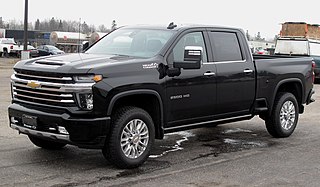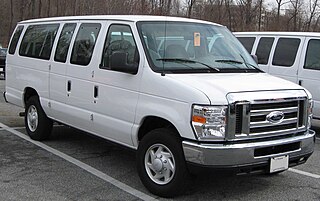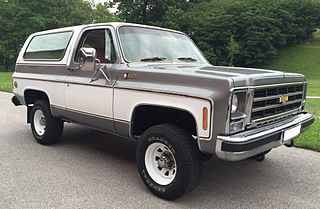
The Chevrolet Silverado is a range of trucks manufactured by General Motors under the Chevrolet brand. Introduced for the 1999 model year, the Silverado is the successor to the long-running Chevrolet C/K model line. Taking its name from the top trim level from the Chevrolet C/K series, the Silverado is offered as a series of full-size pickup trucks, chassis cab trucks, and medium-duty trucks. The fourth generation of the model line was introduced for the 2019 model year.

The Chevrolet C/K is a series of trucks that was manufactured by General Motors from the 1960 to 2002 model years. Marketed by both the Chevrolet and GMC divisions, the C/K series encompassed a wide range of vehicles. While most commonly associated with pickup trucks, the model line also included chassis-cab trucks and medium-duty trucks and served as the basis for GM full-size SUVs. Through its entire production, the model line competed directly against the Ford F-Series and the Dodge D series.

The Ford E-Series is a range of full-size vans manufactured and marketed by the Ford Motor Company. Introduced for 1961 as the replacement of the Ford F-Series panel van, four generations of the model line have been produced. Marketed for both cargo and passenger transport configurations, the E-Series has been designed with multiple design variations for both retail and commercial sale, including vans, and commercial-grade cutaway van chassis and stripped chassis.

The Chevrolet Suburban is a series of SUVs built by Chevrolet since the 1935 model year. The longest-used automobile nameplate in the world, the Chevrolet Suburban is currently in its twelfth generation, introduced for 2021. Beginning life as one of the first metal-bodied station wagons, the Suburban is the progenitor of the modern full-size SUV, combining a wagon-style body with the chassis and powertrain of a pickup truck. Alongside its Advance Design, Task Force, and C/K predecessors, the Chevrolet Silverado currently shares chassis and mechanical commonality with the Suburban and other trucks.

The Chevrolet Tahoe, and its badge-engineered GMC Yukon counterpart, are full-size SUVs and other trucks from General Motors, offered since 1994 and 1991, respectively. Since 1982, Chevrolet and GMC sold two different-sized SUVs under their "Blazer" and "Jimmy" nameplates, by introducing the smaller S-10 Blazer and GMC S-15 Jimmy for the 1983 model year, below the full-size Blazer and Jimmy models. This situation lasted into the early 1990s. GMC first rebadged the full-size Jimmy as the "Yukon" in 1991. Chevrolet however waited until 1994, when they rebadged the redesigned mid-size S-10 Blazer the "new Blazer," while renaming the full-size Blazer as the "Tahoe." The name Tahoe refers to the rugged and scenic area surrounding Lake Tahoe in the western United States, and was originally used as a trim level on S-10 models. The name Yukon refers to the Yukon territory of northern Canada.

The Ford Excursion is a heavy-duty SUV that was sold by Ford Motor Company from 2000 to 2005. At the time of its introduction, the Excursion was the longest and heaviest SUV ever to enter mass production. The third Ford SUV derived from the F-Series pickup trucks, the model line used a heavier-duty chassis and frame than the Expedition; both vehicles competed against the Chevrolet Suburban.

The Chevrolet K5 Blazer is a full-size sport-utility vehicle that was built by General Motors. Being GM's smallest full-size SUV, the K5 Blazer is part of the C/K truck series. Introduced to the Chevrolet line for the 1969 model year, the K5 Blazer was replaced for 1995 by the Chevrolet Tahoe. In 1970, GMC introduced its own model of the truck, called the Jimmy, which was discontinued in 1991 and replaced by the Yukon. The "Jimmy" name was chosen to reflect how GM may sound in a similar manner to how Jeep was thought to be a pronunciation of GP in the competing market. Both were short-wheelbase trucks and available with either rear- or four-wheel drive. Despite all Chevrolet versions from 1969 to 1988 having the "K5" badge, GM never internally referred to the model as the K5 Blazer/K5 Jimmy. Officially, the vehicles have always been referred to as the Blazer/Jimmy, without the K5 prefix. After the release of the S-Series Blazer/Jimmy in 1983, the models were officially renamed "Chevrolet Full-Size Blazer" and "GMC K-Jimmy", though they are often unofficially still addressed as "K5" to avoid confusion.
Flint Assembly is an automobile factory operated by General Motors in Flint, Michigan. It is the city's only vehicle assembly plant after the closure of Buick City. Flint Truck Assembly is also GM's oldest, still operating assembly plant in North America. As of 2022, the Flint factory currently produces full-size pickup trucks. Engine block and cylinder heads were cast at Saginaw Metal Casting Operations, internal engine components were created at Bay City Powertrain and Grand Rapids Operations, and the engines were then assembled at Tonawanda Engine and Romulus Engine. For most of the 20th century Flint Assembly was the home factory for all Chevrolet vehicles.

The Chevrolet and GMC B series was a series of cowled chassis that were produced by General Motors. Produced across three generations from 1966 to 2003, the model line was a variant of medium-duty trucks marketed under the Chevrolet and GMC nameplates. Initially derived from the medium-duty C/K series, later examples were derived from the GMT530 architecture.

The General Motors–Detroit Diesel V8 engine is a series of diesel V8 engines first introduced by General Motors for their C/K pickup trucks in 1982. Developed in collaboration with GM subsidiary Detroit Diesel, the engine family was produced by GM through 2002, when it was replaced by the new Duramax line. AM General's subsidiary General Engine Products (GEP) still produces a military variant of this engine for the HMMWV.

The Chevrolet Kodiak and GMC TopKick are a range of medium-duty trucks that were produced by the Chevrolet and GMC divisions of General Motors from 1980 to 2009. Introduced as a variant of the medium-duty C/K truck line, three generations were produced. Slotted between the C/K trucks and the GMC Brigadier Class 8 conventional, the Kodiak/TopKick were developed as a basis for vocationally oriented trucks, including cargo haulers, dump trucks, and similar vehicles; on later generations, both cutaway and cowled-chassis variants were produced for bus use.

The Chevrolet 90° V6 family of V6 engines began in 1978 with the Chevrolet 200 cu in (3.3 L) as the base engine for the all new 1978 Chevrolet Malibu. The original engine family was phased out in early 2014, with its final use as the 4.3 L (262 cu in) V6 engine used in Chevrolet and GMC trucks and vans. Its phaseout marks the end of an era of Chevrolet small-block engine designs dating back to the 1955 model year. A new Generation V 4.3 L (262 cu in) V6 variant entered production in late 2013, based on the LT1 small block V8 and first used in the 2014 Silverado/Sierra 1500 trucks.

The Nissan NV is a full-size van produced by Nissan from 2011 to 2021. It was developed and marketed for the United States and Canada, where Nissan had not previously been present in the full-size segment. Until the introduction of the Nissan NV, Mexico was the only country in North America selling a full-size Nissan van, as the Nissan Urvan was sold there.

The Chevrolet Van or Chevy Van is a range of vans that was manufactured by General Motors from the 1964 to 1996 model years. Introduced as the successor for the rear-engine Corvair Corvan/Greenbrier, the model line also replaced the panel van configuration of the Chevrolet Suburban. The vehicle was sold both in passenger van and cargo van configurations as well as a cutaway van chassis that served as the basis for a variety of custom applications.
Wentzville Assembly is a General Motors automobile assembly facility in Wentzville, Missouri, opened in 1983. Located at 1500 East Route A in Wentzville, the 3.7 million square foot plant sits on 569 acres approximately 40 miles west of St. Louis, just off of I-70.

The first generation of the C/K series is a range of trucks that was manufactured by General Motors from the 1960 to 1966 model years. Marketed by both the Chevrolet and GMC divisions, the C/K trucks replaced the previous Task Force generation of trucks. The first General Motors pickup trucks developed on a dedicated truck platform, the C/K series included pickup trucks, chassis-cab trucks, and medium/heavy commercial trucks.

The second generation of the C/K series is a range of trucks that was manufactured by General Motors. Marketed by both the Chevrolet and GMC divisions from the 1967 to 1972 model years, this generation was given the "Action Line" moniker by General Motors. As with its predecessor, the second generation C/K included full-size pickup trucks, chassis cab trucks, and medium-duty commercial trucks.

The third generation of theC/K series is a range of trucks that was manufactured by General Motors from the 1973 to 1991 model years. Serving as the replacement for the "Action Line" C/K trucks, GM designated the generation under "Rounded Line" moniker. Again offered as a two-door pickup truck and chassis cab, the Rounded Line trucks marked the introduction of a four-door cab configuration.

The fourth generation of the C/K series is a range of trucks that was manufactured by General Motors. Marketed by the Chevrolet and GMC brands from the 1988 to the 2002 model years, this is the final generation of the C/K model line. In a branding change, GMC adopted the GMC Sierra nameplate for all its full-size pickup trucks, leaving the C/K nomenclature exclusive to Chevrolet.

The first generation of the Chevrolet Silverado is a series of trucks manufactured by General Motors from 1998 until 2007 under the Chevrolet brand and also as the GMC Sierra. Built on the new GMT800 platform, the Silverado/Sierra 1500 and 2500 pickup trucks were first released in August 1998 as 1999 models. The "classic" light-duty GMT400 C/K trucks were kept in production alongside the new types for the first model year, while the heavy-duty GMT400 pickups were continued until 2000, with the new GMT800 Silverado/Sierra HD released in model year 2001. A 3500 model was added later for 2001, with the introduction of the HD moniker. A refresh for 2003 models was introduced in 2002, bringing slight design changes and an upgrade to the audio and HVAC controls. The 2007 GMT800 trucks, built after the new GMT900 had gone on sale, used the name Classic to denote the difference between the two generations.





























